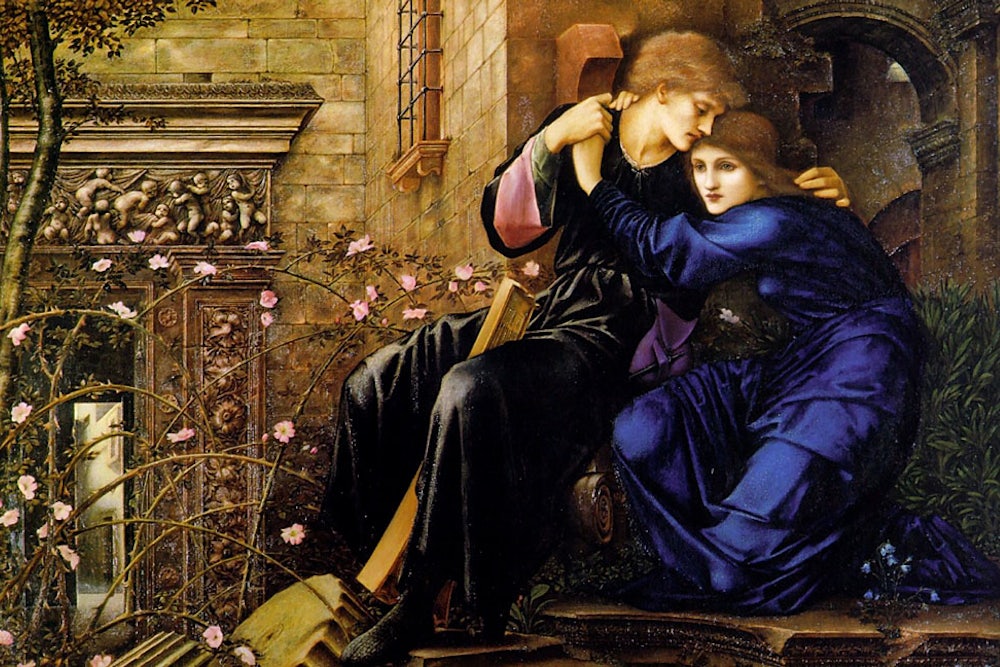The Lord of the Rings is not usually portrayed as a love story. But that epic of magic and monsters and fraternal friendship contains many slivers of romance. As the movie adaptations of the 2000s brought out, the affair between Arwen the elf and Aragorn the man pits the lovers against impossible odds, and yet their love triumphs. Their relationship gives emotional and narrative depth to Aragorn’s heroics, while in the books their marriage symbolizes the everlasting bond between their two races. Romance, in fact, lies at the center of the Lord of the Rings mythology: Before Arwen and Aragorn, there was Beren and Lúthien.
The Tale of Beren and Lúthien, a new book edited by J.R.R. Tolkien’s son Christopher, brings together the many versions of this tale, which is a key element of the Silmarillion, the universe-building compendium that precedes the action in The Lord of the Rings. Beren and Lúthien are ancestors of Arwen and Aragorn, living thousands of years earlier, in the First Age of Middle Earth. The bones of the story have Beren wandering through a wood—in some versions he is a man, in others not. He stumbles upon the beautiful elf Lúthien, who is dancing in a glade, and they fall in love. Her father does not approve of this union between elf and non-elf, and sets him on an impossible quest: to bring him one of the Silmarils—ancient, powerful gems—from the crown of the evil Morgoth. Beren takes on the challenge, and adventure ensues.
As with many of Tolkien’s women, Lúthien is an active and heroic beauty. In the various versions of this story, collected by Christopher from his father’s papers, she weaves spells by dancing; by singing into bowls of water; by charming her own hair. She also makes bold and dangerous choices, defying her father and choosing love over self-preservation.
Beren, meanwhile, is an unusually long-suffering hero. In most versions of the story, he spends endless months in captivity at the hands of evildoers. In valuing his beloved elf above all else, Beren’s heroism becomes one of sacrifice and forbearance. Lúthien is the rescuer, but he proves himself by continually choosing the path that will guarantee misery for himself while leaving his lover’s vow intact.
Tolkien’s vocabulary for love is simple but profound. In one scene, Beren must leave Lúthien, and bids her farewell silently:
One morning as asleep she lay
upon the moss, as though the day
too bitter were for gentle flower
to open in a sunless hour,
Beren arose and kissed her hair,
and wept, and softly left her there.
Of course, she is an elf, which dictates the sylvan qualities of her beauty. But the forest imagery also links Lúthien to a real-life episode in Tolkien’s courtship of his wife.
As Christopher Tolkien writes in his preface, these two lovers were very close to his father’s heart. He wrote their tale after returning from World War I, in 1917. Beren falls in love with the beautiful Lúthien after seeing her dance in a glade filled with hemlocks, just as Tolkien’s wife Edith had danced for him. “In a letter to me on the subject of my mother,” Christopher Tolkien writes, “written in the year after her death, which was also the year before his own, he wrote of his overwhelming sense of bereavement, and of his wish to have Lúthien inscribed beneath her name on the grave.” Tolkien and Edith now rest under gravestones with the names of each lover engraved beneath their own, side by side.
Christopher Tolkien is now 92. As he writes in the book’s preface, “This is (presumptively) my last book in the long series of editions of my father’s writings.” For this final work, he has chosen to edit The Tale of Beren and Lúthien to memorialize his parents and their love. The story is the first that Christopher remembers hearing from his father as a child.
Christopher assisted his father in his works from a young age. He drew up the maps that accompanied the published text of The Lord of the Rings, and was a member of the famous Inklings group along with his father (the group included C. S. Lewis, Owen Barfield, and many other prominent men of letters). Tolkien had meant to publish The Silmarillion but died in 1973 before it was entirely finished. Christopher edited the text from the papers that remained and published it, to fairly consistent praise. Later he would also edit Unfinished Tales and the twelve-volume History of Middle Earth. The most direct precedent for The Tale of Beren and Lúthien is 2007’s The Children of Húrin, a story Christopher edited from various sources from his father’s archive.
It may be that this new tale is the last of his editorial projects, and it should be seen as the capstone to a remarkably consistent and devoted career. In many ways, Christopher Tolkien’s editorial projects resemble the textual criticism practices of medievalists. Tolkien senior was a medievalist at Oxford, and he lectured extensively on the best ways to turn a partial or damaged manuscript into a readable text. His son has done something similar with his own archive.
And The Tale of Beren and Lúthien is more like a scholarly volume than a storybook. There are versions of the tale in verse, and versions in prose. There are versions where the villain is an enormous, evil cat, and versions where the villain is a wolf. Names change frequently. But instead of taking the “best text” route, where the editor chooses a single manuscript to bear witness to the lost story, Christopher Tolkien has offered up what remains and allowed the reader to choose. It’s a generous editorial act, and a fitting tribute in memoriam to his parents’ romance.
